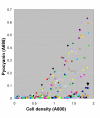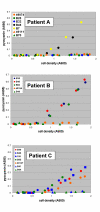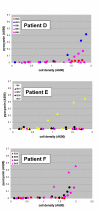Widespread pyocyanin over-production among isolates of a cystic fibrosis epidemic strain
- PMID: 17521417
- PMCID: PMC1890549
- DOI: 10.1186/1471-2180-7-45
Widespread pyocyanin over-production among isolates of a cystic fibrosis epidemic strain
Abstract
Background: Some isolates of the Liverpool cystic fibrosis epidemic strain of Pseudomonas aeruginosa exhibit an unusual virulence-related phenotype, characterized by over-production of quorum sensing-regulated exoproducts such as pyocyanin and LasA protease. Our aim was to determine the prevalence of this unusual phenotype amongst isolates of the epidemic strain, and to study other intraclonal phenotypic and genotypic variations.
Results: The unusual phenotype was detected in at least one epidemic strain isolate from the majority of cystic fibrosis patients tested, and can be retained for up to seven years during chronic infection. Multiple sequential isolates of the epidemic strain taken from six patients over a period of up to nine years exhibited a wide range of phenotypes, including different antimicrobial susceptibilities. Our data suggest that each sputum sample contains a mixture of phenotypes and genotypes within the epidemic strain population, including within colony morphotypes. Many isolates exhibit premature (during early rather than late exponential growth) and over-production of pyocyanin, which has a number of toxic effects directly relevant to cystic fibrosis.
Conclusion: The widespread occurrence of this unusual phenotype suggests that it may play an important role in the success of the epidemic strain.
Figures




References
-
- Latifi A, Winson MK, Foglino M, Bycroft BW, Stewart GS, Lazdunski A, Williams P. Multiple homologues of LuxR and LuxI control expression of virulence determinants and secondary metabolites through quorum sensing in Pseudomonas aeruginosa PAO1. Mol Microbiol. 1995;17:333–343. doi: 10.1111/j.1365-2958.1995.mmi_17020333.x. - DOI - PubMed
MeSH terms
Substances
LinkOut - more resources
Full Text Sources
Other Literature Sources
Medical

